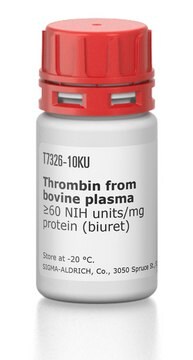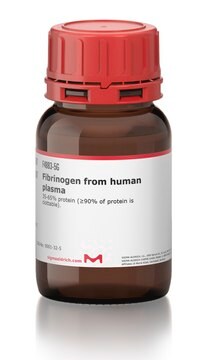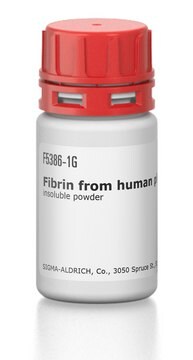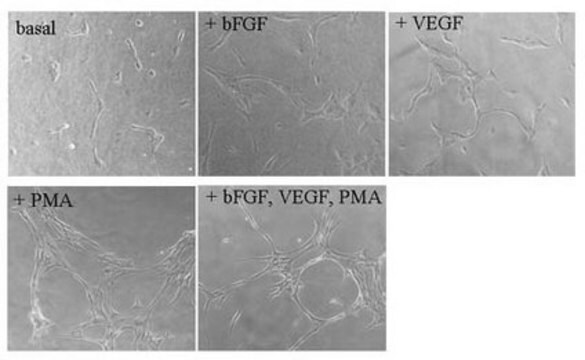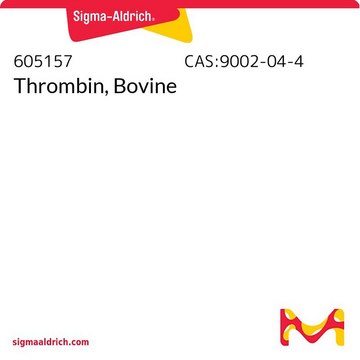F8630
Fibrinogen from bovine plasma
Type I-S, 65-85% protein (≥75% of protein is clottable)
Synonym(s):
Factor I
Sign Into View Organizational & Contract Pricing
All Photos(6)
About This Item
Recommended Products
biological source
bovine plasma
Quality Level
type
Type I-S
form
powder
mol wt
α-chain 63.5 kDa
β-chain 56 kDa
γ chain 47 kDa (about 4% carbohydrate content)
soluble dimer 340 kDa
concentration
65-85% (biuret)
technique(s)
cell culture | mammalian: suitable
storage temp.
−20°C
Gene Information
cow ... FGA(522039) , FGB(510522) , FGG(280792)
Looking for similar products? Visit Product Comparison Guide
Application
Fibrinogen has been used in studies of haemostatic therapy in surgical and massive trauma patients. These studies have shown that fibrinogen may prove to be more superior in stopping blood loss when compared to using fresh frozen plasma (FFP).
Biochem/physiol Actions
Fibrinogen is an acute phase protein that is part of the coagulation cascade of proteins. The end result of the cascade is the production of thrombin that converts fibrinogen to fibrin. Thrombin rapidly proteolyzes fibrinogen, releasing fibrinopeptide A. The loss of this small peptide is not sufficient to make the resulting fibrin molecule insoluble, but it tends to form complexes with adjacent fibrin and fibrinogen molecules. Thrombin then cleaves a second peptide, fibrinopeptide B, from fibrin and the fibrin monomers formed then polymerize spontaneously to form an insoluble gel. The polymerized fibrin is held together by noncovalent and electrostatic forces and stabilized by the transamidating enzyme, factor XIIIa, that is produced by the action of thrombin on factor XIII. The insoluble fibrin aggregates (clots) and aggregated platelets then block the damaged blood vessel and prevent further bleeding. The amount of fibrinogen in the plasma can serve as a nonspecific indicator of whether or not an inflammatory process is present in the body. Fibrinogen from any mammalian source will be cleaved by thrombin from any mammalian source.
Physical form
Contains ~10% sodium citrate and ~15% sodium chloride.
Reconstitution
The optimal way to solubilize fibrinogen is to layer it on top of warm (37 ºC) saline, as fibrinogen will not dissolve in water. The saline concentration can be in the range of 0.85-0.9%. The fibrinogen-saline solution can be gently agitated, but it must not be vortexed. The fibrinogen will slowly dissolve to give a hazy solution. Fibrinogen may be sterile-filtered, but may not go through a 0.1 μm filter. A 0.2 μm filter is suggested, with positive pressure using a syringe and "button" filter. Vacuum filtration should not be used, since this will lead to breakdown of the molecule during the filtration.
Analysis Note
Protein determined by biuret
Storage Class Code
11 - Combustible Solids
WGK
WGK 3
Flash Point(F)
Not applicable
Flash Point(C)
Not applicable
Personal Protective Equipment
dust mask type N95 (US), Eyeshields, Gloves
Choose from one of the most recent versions:
Already Own This Product?
Find documentation for the products that you have recently purchased in the Document Library.
Customers Also Viewed
Katarzyna Kubiak et al.
Colloids and surfaces. B, Biointerfaces, 139, 123-131 (2015-12-27)
Adsorption kinetics of fibrinogen at a gold substrate at various pHs was thoroughly studied using the QCM-D method. The experimental were interpreted in terms of theoretical calculations performed according to the random sequential adsorption model (RSA). In this way, the
Johanna Prüller et al.
PloS one, 13(9), e0202574-e0202574 (2018-09-18)
Biophysical/biochemical cues from the environment contribute to regulation of the regenerative capacity of resident skeletal muscle stem cells called satellites cells. This can be observed in vitro, where muscle cell behaviour is influenced by the particular culture substrates and whether
C Fenger-Eriksen et al.
British journal of anaesthesia, 101(6), 769-773 (2008-09-27)
Patients experiencing massive haemorrhage are at high risk of developing coagulopathy through loss, consumption, and dilution of coagulation factors and platelets. It has been reported that plasma fibrinogen concentrations may reach a critical low level relatively early during bleeding, calling
Navid Hakimi et al.
Lab on a chip, 18(10), 1440-1451 (2018-04-18)
We present a handheld skin printer that enables the in situ formation of biomaterial and skin tissue sheets of different homogeneous and architected compositions. When manually positioned above a target surface, the compact instrument (weight <0.8 kg) conformally deposits a
Yuya Nakatani et al.
Archives of oral biology, 73, 172-178 (2016-10-25)
Platelet-rich plasma (PRP) is typically isolated and applied immediately after preparation, making it both a time- and labor-intensive addition to the operative procedure. Thus, it would be convenient if PRP could be preserved. We evaluated the efficacy of freeze-dried PRP
Our team of scientists has experience in all areas of research including Life Science, Material Science, Chemical Synthesis, Chromatography, Analytical and many others.
Contact Technical Service


